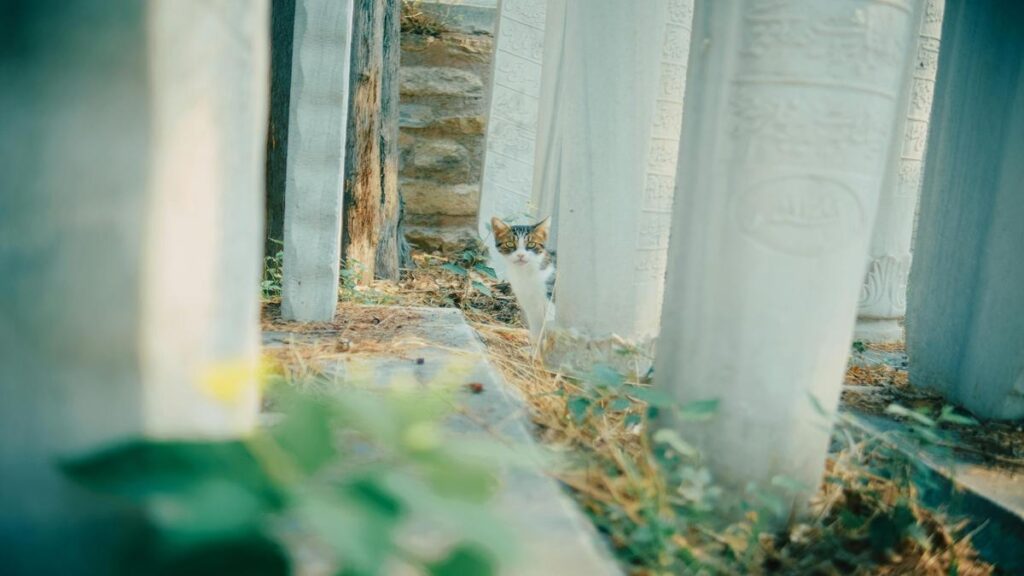Discovering your cat’s secret sounds can be an exciting journey. In this article, we will dive into the 7 meanings behind those unique vocalizations your feline friend makes. From purrs to meows, we’ll help you decode what your cat is really trying to say.
Understanding these sounds can strengthen your bond, making communication smoother and clearer.
Let’s uncover the secrets of your cat’s world together!
Key Insights
- Cats make different sounds to communicate with you.
- A purr usually means your cat is happy and relaxed.
- A meow can ask for attention or food.
- Hissing shows your cat feels scared or threatened.
- Chirps may mean your cat is excited about something, like birds.

Summary
What Are Cat’s Secret Sounds?
Cats are fascinating creatures, aren’t they? They have this whole secret language that we, as humans, often struggle to understand. It’s not just about meowing; they have a range of sounds that convey different feelings and messages. Think about it: have you ever heard your cat make a weird noise and wondered what it meant? Well, you’re not alone!
Understanding your cat’s vocalizations can really enhance your bond. It’s like learning to speak their language. So, let’s dive into the world of cat sounds and uncover their secrets together!
Understanding Cat Vocalizations: The Basics
Alright, so let’s start with the basics. Cats communicate in various ways. They use body language, scent, and, of course, vocalizations. When it comes to sounds, cats have a unique way of expressing themselves.
You might notice that your cat’s vocalizations can change depending on the situation. For instance, a playful meow might sound different from a distressed yowl. It’s all about context. Generally, cats have a few main types of sounds they use:
- Meows: These are the classic cat sounds we all know. They can vary in pitch and length.
- Purrs: Often associated with contentment, but can also indicate pain or distress in some cases.
- Hisses: A clear sign that your cat feels threatened or scared.
- Chirps or Chattering: Usually heard when they’re watching birds or small prey.
- Yowls: Typically a loud, prolonged sound that can indicate mating calls or distress.
By understanding these basic sounds, you can start to grasp what your feline friend is trying to tell you.
The 7 Meanings Behind Cat Sounds
Now, let’s break down some of the most common cat sounds and what they might mean. Here are seven meanings behind those secret cat sounds:
- The Classic Meow: This is probably the sound you hear the most. Cats meow to communicate with humans, and each meow can have a different meaning. A high-pitched meow might mean they want attention, while a lower, more drawn-out meow could indicate annoyance.
- Purring: While purring often signifies happiness, don’t be fooled. Cats can also purr when they’re in pain or feeling anxious. It’s their way of self-soothing.
- Chirping or Chattering: This sound usually happens when your cat is watching birds or squirrels. It’s thought to mimic the sounds of birds, possibly as an instinctual hunting behavior.
- Hissing and Growling: These sounds are clear indicators that your cat feels threatened or scared. It’s their way of saying, Back off!
- Yowling: This loud, drawn-out sound is often associated with mating calls in unspayed or unneutered cats. However, it can also indicate discomfort or a desire for attention.
- Trilling: This is a sweet sound that’s often a greeting. It’s a mix between a meow and a purr and is usually accompanied by a friendly demeanor.
- Silent Meows: Sometimes, you might see your cat open their mouth as if they’re meowing, but no sound comes out. This can be a sign of affection or an attempt to get your attention without being too loud.
Understanding these meanings can help you respond to your cat’s needs more effectively.
Types of Cat Noises You Should Know
Let’s get a bit more specific. Here are some types of cat noises that you should definitely keep an ear out for:
- The Soft Meow: This is usually a gentle request for attention. Think of it as your cat saying, Hey, I’m here! Can you pet me?
- The Demanding Meow: This one is louder and more insistent. Your cat might be hungry or want to play. It’s their way of saying, I need something, and I need it now!
- The Purr: As mentioned earlier, purring is often associated with contentment. But if your cat is purring while hiding or acting strangely, it could indicate discomfort.
- The Yowl: This is a serious sound. If your cat is yowling, it could mean they’re in distress or feeling threatened. It’s time to check in on them.
- The Chirp: This cute sound is often made when your cat is excited about something. It’s like a little celebration when they see a bird outside.
- The Hiss: If your cat hisses, take it seriously. It’s a warning sign that they feel threatened. Give them space.
- The Growl: Similar to hissing, a growl is a deeper sound that indicates aggression or fear. It’s best to back off and let your cat calm down.
Knowing these different types of noises can help you interpret what your cat is feeling in various situations.
How to Interpret Cat Sounds Like a Pro
Interpreting cat sounds can feel like a puzzle sometimes. But with a little practice, you can become a pro at understanding your furry friend. Here are some tips to help you decode their vocalizations:
- Pay Attention to Context: Always consider the situation. Is your cat meowing while sitting by their food bowl? They’re probably hungry. If they’re hissing when another pet approaches, they feel threatened.
- Observe Body Language: Sounds are just one part of communication. Look at your cat’s body language. Are their ears back? Is their tail puffed up? These are signs of fear or aggression.
- Take Note of Frequency and Duration: A quick meow might mean something different than a prolonged one. If your cat is yowling for a while, it’s likely they’re trying to express something important.
- Listen for Changes: If your cat suddenly changes their vocalization, it could indicate a shift in their mood or health. For example, if a normally quiet cat starts yowling, it might be time for a vet visit.
- Trust Your Instincts: Sometimes, you just know when something isn’t right. If your cat’s behavior changes drastically, trust your gut and investigate further.
By honing your observation skills, you’ll become much better at interpreting what your cat is trying to say.
Feline Behavior: What Your Cat is Trying to Say
Now that we’ve covered the sounds, let’s talk about the behavior that often accompanies them. Cats are creatures of habit, and their behavior can tell you a lot about their feelings.
For example, if your cat is rubbing against your leg while meowing, they’re likely seeking affection. On the flip side, if they’re hiding and making low growling sounds, they might be feeling stressed or scared.
It’s also important to note that cats are territorial animals. If your cat is making loud noises while watching another cat outside, they could be asserting their territory.
Understanding these behaviors can help you create a comfortable environment for your cat. Always be attentive to changes in their behavior, as it can indicate their emotional state.
If you haven’t bought your area box yet, try this one, click here.
Want to Know More About This Amazing Product?
If you’re curious about the Neakasa M1 and its standout features, you’ve come to the right place! This innovative product has been making waves for its cutting-edge design and top-tier performance. Whether you’re looking for efficiency, durability, or smart functionality, the Neakasa M1 delivers on all fronts.
For a detailed review, including pros, cons, and real-world performance insights, check out our in-depth analysis here: Neakasa M1 Review – Is It Worth It?.
Stay ahead of the curve and discover why the Neakasa M1 might just be the perfect addition to your tech collection!
Cat Emotions: Decoding Their Meows and Purrs
Cats experience a range of emotions, just like we do. Their sounds can give us insight into how they’re feeling. Here’s a quick rundown of what their meows and purrs might reveal:
- Happy: If your cat is purring and kneading on your lap, they’re feeling cozy and content. This is a sign of trust.
- Playful: A chirp or a series of soft meows can indicate that your cat is ready to play. They might be feeling energetic and want to engage with you.
- Stressed: If your cat is hissing or growling, they’re likely feeling threatened. This could be due to a new pet in the house or a change in their environment.
- Curious: A series of short meows can indicate curiosity. Your cat might have spotted something interesting and wants to investigate.
- Lonely: If your cat is yowling or meowing loudly when you’re not around, they might be feeling lonely and want your attention.
By recognizing these emotional cues, you can respond appropriately and provide the comfort your cat needs.
Why Understanding Cat Communication Matters
So, why should you care about understanding your cat’s communication? Well, for starters, it can improve your relationship with your furry friend. When you know what your cat is trying to tell you, you can respond to their needs more effectively.
Plus, being in tune with your cat’s sounds and behaviors can help you identify potential health issues early on. If your normally quiet cat suddenly starts yowling or acting differently, it could be a sign that something is wrong.
Understanding cat communication also allows you to create a more enriching environment for your pet. When you know what they like and dislike, you can provide them with toys, activities, and spaces that cater to their needs.
In short, being able to interpret your cat’s secret sounds can lead to a happier, healthier, and more fulfilling life for both you and your feline companion.
Tips for Better Communication with Your Pet Cat
Want to improve communication with your cat? Here are some practical tips to help you connect better:
- Spend Quality Time Together: The more time you spend with your cat, the better you’ll understand their sounds and behaviors. Play with them, cuddle, and just hang out.
- Talk to Your Cat: Believe it or not, talking to your cat can enhance your bond. Use a soft voice and respond to their sounds. You might be surprised by how they react!
- Observe and Learn: Take note of your cat’s vocalizations and behaviors. Keep a journal if you want to track changes over time. This can help you spot patterns.
- Be Patient: Understanding your cat takes time. Don’t get frustrated if you don’t get it right away. Just keep observing and learning.
- Provide a Safe Space: Make sure your cat has a safe and comfortable environment. This can reduce stress and help them feel more secure, leading to better communication.
Following these tips, you will be on the right path to becoming a communication expert with cats!
Conclusion
In conclusion, decoding your cat’s secret sounds is not just a fun endeavor; it’s a vital part of nurturing your relationship with your furry friend. Each meow, purr, hiss, and chirp carries its own meaning, and understanding these vocalizations can help you respond to your cat’s needs more effectively.
Remember, it’s all about context and observation. The more you tune in to their unique language, the deeper your bond will grow.
So, take a moment to listen, observe, and engage with your cat. You’ll find that every sound they make is a little piece of their personality, waiting for you to discover. If you’re eager to learn more about your feline companion and enhance your understanding of their world, don’t hesitate to check out more articles at Tech Havela.
Happy cat communicating!
Frequently asked questions
What are the common sounds cats make?
Cats make many sounds! You might hear meows, purrs, hisses, and chirps. Each sound has its own meaning.
What does a cat’s meow mean?
A meow can mean different things! Your cat might be asking for food, attention, or just saying hello.
Why do cats purr?
When your cat purrs, it usually means they’re happy and relaxed. It’s like their way of saying “I’m comfy!”
What does a cat’s hiss mean?
A hiss is a warning! It means your cat feels scared or threatened. It’s best to give them space when they hiss.
Why do cats chirp or chitter?
Chirping can happen when your cat sees birds! It’s their way of expressing excitement or maybe frustration.
What does it mean when a cat howls?
Howling can mean your cat is very upset or in pain. It might also signal they’re feeling lonely.
Can cats communicate with their tails or ears?
Yes! Your cat’s tail and ears tell you a lot. A high tail means happiness, while flattened ears show fear.
**Sidnir Vieira**
Founder of TechHavela
A passionate pet and tech content creator, helping dog owners across the U.S. make smarter decisions for their furry friends.



